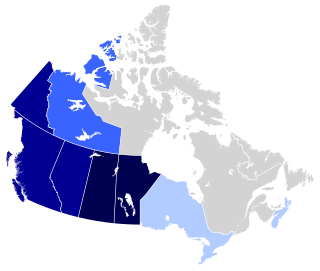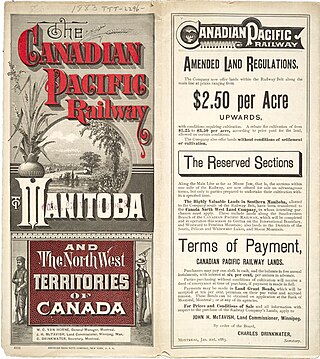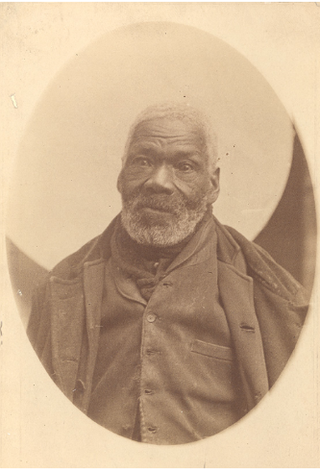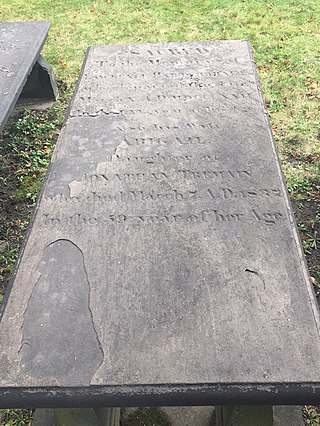| Total population | |
|---|---|
| + 1,000,000 (by ancestry, 2021 Census ) [1] | |
| Regions with significant populations | |
| Ontario • Western Canada • Atlantic Canada • Quebec | |
| Languages | |
| French, English | |
| Religion | |
| Protestantism • Catholicism • Latter Day Saints • Eastern or Oriental Orthodox Minorities adhering to: Judaism • Islam • Buddhism • Hinduism • Scientology • Wicca or other Paganism • Others |
American Canadians are Canadians of American descent. The term is most often used to refer to Canadians who migrated from or have ancestry from the United States. This may include people born in the United States who have naturalized as Canadian citizens. Many American Canadians hold both US and Canadian citizenship.
According to the 2016 Census, 29,590 Canadians reported American as being their singular ethnicity, while 347,810 reported partial ancestry. [1]
Americans have moved to Canada throughout history. During the American Revolution, many white Americans, 15-25% of the population (300-500,000), loyal to the British crown left the United States and settled in Canada. By 1783, 46,000 had settled in Ontario (10,000) and the Maritimes (36,000). 9.000 lived in the Eastern Townships by 1800. These early settlers were officially designated United Empire Loyalists and referred to as the King's Loyal Americans. Many Black Canadians are descendants of African American slaves (Black Loyalists) who fled to Canada during the American Revolution. Similar waves of American immigrants, 30,000, lured by promises of land if they swore a loyalty oath to the King, settled in Ontario before the War of 1812. The Black Refugees in the War of 1812 also fled to Canada and many American slaves also came via the Underground Railroad, most settling in either Halifax, Nova Scotia or Southern Ontario. At the outbreak of the war of 1812 80,000 of 110,000 inhabitants in Ontario were American born or descendants of Americans. In the Maritimes 110,000 of 135,000 were Americans who settled before 1775 or after and their descendants. This fact gave English-speaking Canada a pronounced American cultural flavor into the 1830s. The difference was political: those who disliked the split with Britain and those who supported it. [2]
In the early 20th century, over 750,000 American settlers moved into the farming regions of the Prairie Provinces of Alberta, Manitoba and Saskatchewan. Many of these were immigrants (or children of immigrants) from Europe or Eastern Canada who had gone to the United States looking for farm land only to find the supply of free farmsteads there exhausted. Others were old-stock European Americans (from the Midwest and Upper South regions of the US), and a small percentage were racial minorities, such as African Americans. In 1916, Americans accounted for 36% of all the foreign-born residents of Alberta, 30% in Saskatchewan, and 8% in Manitoba. [3] or about 400,000 in a total population of the three provinces close to 1.5 million. Not all stayed.
During the Vietnam War era, many American draft dodgers fled to Canada to avoid the war. About 10,200 Americans moved to Canada in 2006; this was the highest number since 1977. [4]

The United States is a country primarily located in North America. Demographics of the United States concern matters of population density, ethnicity, education level, health of the populace, economic status, religious affiliations, and other aspects regarding the population.
Russian Germans in North America are descended from the many ethnic Germans from Russia who emigrated to North America.

United Empire Loyalist is an honorific title which was first given by the 1st Lord Dorchester, the Governor of Quebec and Governor General of the Canadas, to American Loyalists who resettled in British North America during or after the American Revolution. At that time, the demonym Canadian or Canadien was used to refer to the indigenous First Nations groups and the descendants of New France settlers inhabiting the Province of Quebec.

Black Canadians, also known as Afro-Canadians, are Canadians of African or Afro-Caribbean descent. The majority of Black Canadians are of Afro-Caribbean and African origin, though the Black Canadian population also consists of African Americans in Canada and their descendants.

The United Counties of Stormont, Dundas and Glengarry (SDG) is an upper-tier municipality in the Canadian province of Ontario that comprises three historical counties and excludes the City of Cornwall and the Mohawk Nation of Akwesasne. However, both Cornwall and Akwesasne form part of a larger census division named for the United Counties of Stormont, Dundas and Glengarry. The municipality's administrative office is located within Cornwall.

Ukrainian Canadians are Canadian citizens of Ukrainian descent or Ukrainian-born people who immigrated to Canada.
Hungarian Canadians are persons in Canada of Hungarian ancestry. According to the 2016 Census, there are 348,085 Canadians of Hungarian ancestry. The Hungarian minority is the 24th largest ethnic group of Canada. The bulk of Hungarian immigration occurred after World War II, with the wave peaking after the 1956 Hungarian revolution against communist rule, when over 100,000 Hungarian refugees went to Canada. The Hungarian Canadian community is among the country's multiple ethnicities; Canada is one of the top five countries of the Hungarian diaspora.
Icelandic Canadians are Canadian citizens of Icelandic ancestry, or Iceland-born people who reside in Canada.

A block settlement is a particular type of land distribution which allows settlers with the same ethnicity to form small colonies. This settlement type was used throughout western Canada between the late 19th and early 20th centuries. Some were planned and others were spontaneously created by the settlers themselves. As a legacy of the block settlements, the three Prairie Provinces have several regions where ancestries other than British are the largest, unlike the norm in surrounding regions.
Canadian identity refers to the unique culture, characteristics and condition of being Canadian, as well as the many symbols and expressions that set Canada and Canadians apart from other peoples and cultures of the world. Primary influences on the Canadian identity trace back to the arrival, beginning in the early seventeenth century, of French settlers in Acadia and the St. Lawrence River Valley, and of English, Scottish and Irish settlers in Newfoundland and the Maritimes, the British conquest of New France in 1763, the migration of United Empire Loyalists to Upper Canada and New Brunswick, and the ensuing dominance of French and British culture in the gradual development of both an imperial and national identity.

Asian Canadians are Canadians who were either born in or can trace their ancestry to the continent of Asia. Canadians with Asian ancestry comprise both the largest and fastest growing group in Canada, after European Canadians, forming approximately 20.2 percent of the Canadian population as of 2021. Most Asian Canadians are concentrated in the urban areas of Southern Ontario, Southwestern British Columbia, Central Alberta, and other large Canadian cities.

Black refugees were black people who escaped slavery in the United States during the War of 1812 and settled in Nova Scotia, New Brunswick, and Trinidad. The term is used in Canada for those who settled in Nova Scotia and New Brunswick. They were the most numerous of the African Americans who sought freedom during the War of 1812. The Black refugees were the second group of African Americans, after the Black Loyalists, to flee American enslavement in wartime and settle in Canada. They make up the most significant single immigration source for today's African Nova Scotian communities. During the antebellum period, however, an estimated 10,000 to 30,000 Black refugees reached freedom in Canada, often traveling alone or in small family groups.

The Nova Scotian Settlers, or Sierra Leone Settlers, were African Americans who founded the settlement of Freetown, Sierra Leone and the Colony of Sierra Leone, on March 11, 1792. The majority of these black American immigrants were among 3,000 African Americans, mostly former slaves, who had sought freedom and refuge with the British during the American Revolutionary War, leaving rebel masters. They became known as the Black Loyalists. The Nova Scotian Settlers were jointly led by African American Thomas Peters, a former soldier, and English abolitionist John Clarkson. For most of the 19th century, the Settlers resided in Settler Town and remained a distinct ethnic group within the Freetown territory, tending to marry among themselves and with Europeans in the colony.
British Canadians primarily refers to Canadians who were either born in or can trace their ancestry to the British Isles, which includes the nations of England, Ireland, Scotland, Wales, and Northern Ireland.
European Canadians, or Euro-Canadians, are Canadians who were either born in or can trace their ancestry to the continent of Europe. They form the largest panethnic group within Canada.

During the American Revolution, those who continued to support King George III of Great Britain came to be known as Loyalists. Loyalists are to be contrasted with Patriots, who supported the Revolution. Historians have estimated that during the American Revolution, between 15 and 20 percent of the white population of the colonies, or about 500,000 people, were Loyalists. As the war concluded with Great Britain defeated by the Americans and the French, the most active Loyalists were no longer welcome in the United States, and sought to move elsewhere in the British Empire. The large majority of the Loyalists remained in the United States, however, and enjoyed full citizenship there.
The African-American diaspora refers to communities of people of African descent who previously lived in the United States. These people were mainly descended from formerly enslaved African persons in the United States or its preceding European colonies in North America that had been brought to America via the Atlantic slave trade and had suffered in slavery until the American Civil War. The African-American diaspora was primarily caused by the intense racism and views of being inferior to white people that African Americans have suffered through driving them to find new homes free from discrimination and racism. This would become common throughout the history of the African-American presence in the United States and continues to this day.

American immigration to Canada was a notable part of the social history of Canada. Over Canada's history various refugees and economic migrants from the United States would immigrate to Canada for a variety of reasons. Exiled Loyalists from the United States first came, followed by African-American refugees, economic migrants, and later draft evaders from the Vietnam War.

West Asian Canadians, officially known as West Central Asian and Middle Eastern Canadians are Canadians who were either born in or can trace their ancestry to West Asia and Central Asia. The term West Asian Canadian is a subgroup of Asian Canadians and Middle Eastern Canadians. According to Statistics Canada, West Asian Canadians are considered visible minorities and can be further divided by nationality, such as Iranian Canadian or Afghan Canadian.

Black Canadians migrated north in the 18th and 19th centuries from the United States, many of them through the Underground Railroad, into Southwestern Ontario, Toronto, and Owen Sound. Black Canadians fought in the War of 1812 and Rebellions of 1837–1838 for the British. Some returned to the United States during the American Civil War or during the Reconstruction era.